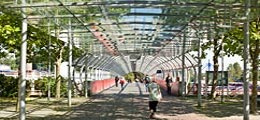CeBiTec – Colloquium
Monday, April 26, 2021, 13 s.t.
Online meeting with Zoom
Dr. Henrike Niederholtmeyer
Max Planck Institute for Terrestrial Microbiology, Marburg
Engineering spatial organization in biomimetic systems
Spatial organization is a defining characteristic of all living organisms but has been challenging to engineer from the bottom up. By colocalizing specific reactions and separating others, synthetic compartments have the potential to improve the biochemical capabilities of artificial cells and cell-free systems. I will present our recent efforts in engineering spatial organization in biomimetic systems. We use microfluidics to produce porous polymeric cell-mimics containing nucleus-like DNA-hydrogel compartments that are able to express and display proteins. Cell-mimics communicate with each other through diffusive protein signals, which supports the formation of protein gradients in dense cell-mimic communities. Additionally, we have developed lipid sponge droplets as programmable synthetic organelles. Lipid sponge droplets are stable and biocompatible synthetic compartments that self-assemble from a single-chain galactolipid and nonionic detergents. Containing dense membrane networks intersected by nanometric aqueous channels lipid sponge droplets provide reaction spaces for both transmembrane and soluble proteins. We have demonstrated that lipid sponge droplets can be programmed to internally concentrate specific proteins, to host and accelerate biochemical transformations, and to rapidly and reversibly sequester and release proteins to control enzymatic reactions. Our results show that a combination of biological and synthetic materials facilitates the engineering of spatial organization in biomimetic systems and will help integrate increasingly complex functions in artificial cells and cell-free systems.
Host: Prof. Dr. Volker Wendisch



